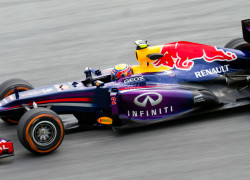
With the 2013 Formula 1 season already halfway through, we thought we’d give you a little technical round up of some of the major changes the teams have made to their cars. There were some drastic changes and some not so drastic. A big complication for the teams has been the tyres deforming under load and changing the aerodynamic properties of the tyre and indirectly, the car. Teams have had to become rather creative in their efforts to minimise the effects of the deforming tyres.
Red Bull
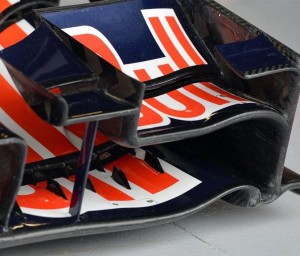 Red Bull have made significant changes to their front wing.
Red Bull have made significant changes to their front wing.
They now have a 7 tiered front wing with the biggest change being the addition of vertical vortex generators at the bottom of the wing (bottom tier). These vortex generators serve two functions. Firstly, they help direct airflow more efficiently over the top of the first tier and below the bottom of the second tier. It also allows them to run the wing at a greater angle of attack without stalling it to some extent. The second function is that it also prevents rubber marbles from being lodged between the elements which can affect the efficiency of the wing.
The nose of the RB9 has also undergone some changes. The “hammer head” nose has been dropped and the FOM cameras are now being placed further back along the nose of the car.
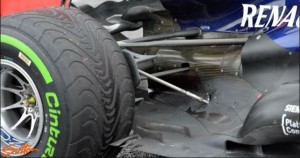 At the rear of the car, just in front of the tyre, Red Bull have added three slots in the floor along with a second vertical vane. The slots in the floor help to minimise the tyre squirt, which affects the efficiency of the diffusers. The extra vertical vane helps to better channel the exhaust gasses towards the rear diffuser. The rear wing features the same vertical slot on the endplate as seen on the McLaren, Marussia and Force India. This also helps to minimise the effect of the tyre squirt.
At the rear of the car, just in front of the tyre, Red Bull have added three slots in the floor along with a second vertical vane. The slots in the floor help to minimise the tyre squirt, which affects the efficiency of the diffusers. The extra vertical vane helps to better channel the exhaust gasses towards the rear diffuser. The rear wing features the same vertical slot on the endplate as seen on the McLaren, Marussia and Force India. This also helps to minimise the effect of the tyre squirt.
Tyre squirt is the turbulent air around the tyre that is generated by the spinning tyre while the car is moving forward.
Ferrari
Starting at the front with Ferrari, they’ve added an additional slot on the outer section of the front wing endplate. Unlike Red Bull, their front wing has only 6 tiers.
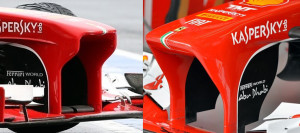
The front wing pillars have changed from their launch spec. It now features a straighter design, instead of the previous stepped configuration.
There was also a different low down force configuration front wing which was used at the Canadian Grand Prix. It is very likely that we’ll see this wing again at the Italian Grand Prix.
The new side pod airflow conditioners that run across the top of the side pod, which we’ve seen at the Spanish Grand Prix, have been dropped for the more conventional design the car had on when it was launched. They’ve never reverted back to the new design since.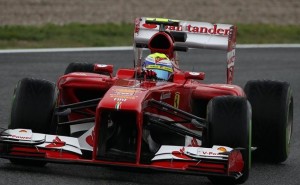
There’s also been an addition of another horizontal vortex generator just ahead of the wing mirror. This improves the airflow around the side of the car and over the side pod to assist the coanda exhausts.
Behind the side pods, but just ahead of the exhaust, Ferrari have introduced a series of cooling ducts. These ducts help with the cooling, but also aid in re-attaching the airflow around the bottom of the car.
Mercedes
The Brackley based Mercedes F1 team have given us the impression that they’ve been working much harder than all the other teams, especially with their very high tyre degradation problems. They’ve introduced lots of changes around the car in order to find the balance between their qualifying pace and their race pace.
Starting with the front wing, the most noticeable change is that they now have a 5 tiered wing. This was done by adding an additional slot to the main plane and creating and extra upper flap.
 The vertical element has also been changed by adding a turning vane to the leading edge. The front wing pillars have a similar took to the Ferrari solution and extend from the nose of the car downward to the wing.
The vertical element has also been changed by adding a turning vane to the leading edge. The front wing pillars have a similar took to the Ferrari solution and extend from the nose of the car downward to the wing.
Under the nose cone, Mercedes have been running slotted turning vanes. The slots allow for improved airflow around fast corners.
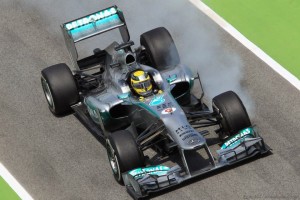
Under the wing mirrors they’ve replaced the three horizontal vortex generators with
The floor in front of the rear wheels features one slot, as opposed to the three slots that Red Bull are running. There is also a longer strake running perpendicular to the tyre to better manage the exhaust gas flow to the diffuser.one large one to better control the airflow over the side pods.


